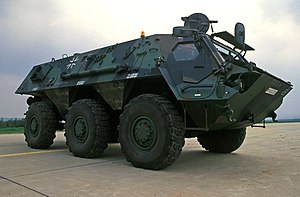TPz Fuchs
This article needs additional citations for verification. (February 2012) |
| TPz Fuchs | |
|---|---|
 TPz 1A3 Fuchs NBC reconnaissance vehicle | |
| Type | Armoured Personnel Carrier |
| Place of origin | |
| Service history | |
| Used by | Bundeswehr |
| Production history | |
| Manufacturer | Thyssen-Henschel |
| Produced | 1979-present |
| Specifications | |
| Mass | 18.3 t |
| Length | 7.33 m (24 ft 1 in) |
| Width | 2.98 m (9 ft 9 in) |
| Height | 2.37 m (7 ft 9 in) |
Main armament | Up to three Rheinmetall MG3 |
Secondary armament | MILAN anti-tank guided missile, smoke grenade launchers |
| Engine | Mercedes-Benz Model OM 402A V-8 liquid-cooled diesel 320 hp |
| Payload capacity | 6 t |
| Suspension | 6x6 |
Operational range | 800 km (500 mi) |
| Maximum speed | 105 km/h (65 mph) 10 km/h (6.2 mph) in water |
TPz (Transportpanzer) Fuchs ("fox") is an armoured personnel carrier developed by Daimler-Benz and built by Thyssen-Henschel[1] in 1979. It was the second wheeled armoured vehicle to be fielded in the Bundeswehr. It is used for tasks including troop transport, engineer transport, bomb disposal, NBC (Nuclear, Biological and Chemical) reconnaissance and electronic warfare. In selecting models and retrofit kits, more than 90 combinations are possible; 32 have been produced. The TPz Fuchs is thus referred to as a "retrofit platform".
The engine is a Mercedes-Benz Model OM 402A V-8 liquid-cooled 320 HP diesel. Its top speed is 105 km/h and the range is 800 km. It is 7.33 m long, 2.98 m wide and 2.37 m high. It weighs 18.3 tons with the capability to carry 6 tons in equipment. The 6x6 APC has high performance over many terrains, with low noise. Its rear-mounted propellers with 360° turning range enable it to take water obstacles at 10 km/h.
Armament
The TPz Fuchs can be equipped with three Rheinmetall MG3 general purpose machine guns, one of which is mounted on a manually controlled turret. Fuchs' of the Armoured Reconnaissance Battalion, Panzergrenadiers mechanized infantry, the Franco-German Brigade, the mountain infantry and the Jäger (rangers) of the German Army are armed with MILAN anti-tank-guided missiles and a maximum of two MG3s. Fuchs' deployed in Afghanistan were equipped with a GMG grenade launcher or an M2 Browning heavy machine gun instead of a MG3.
Improvements over the years
Improvements concentrated on the ability to withstand high-performance, armour-piercing ammunition fired from small arms and lightweight carriage-mounted machine guns, as well as shrapnel (e.g. from artillery rounds), and anti-personnel and antitank mines.
Due to the weight and volume restrictions, advanced armour materials are used to meet the protection specifications, which compared to equally effective steel or aluminum alloy armour, can reduce weight by 50%.
The modular armour protection system has six harmonized elements which in part operate in coordinated fashion:
- Add-on armour mounted to the exterior of the vehicle housing
- Anti-mine protective plating in the wheel cases
- Reinforced bullet-proof windows
- Reinforced bullet-proof visors for shielding the window exteriors
- Spall-lining of all interior surfaces of the vehicle compartment
- A shielded gun mounting (except on the medical vehicles)
Users
Most vehicles are in service with the German Army (1,003 - 144 upgraded) the rest are in the armed forces of Saudi Arabia (36), The Netherlands (23), USA (123, as M93 Fox) and Venezuela (10). The Fuchs served in Gulf war and in peace-keeping operations with German KFOR troops in former Yugoslavia and with German ISAF in Afghanistan. The United Kingdom operated 11 vehicles until 2011 when the Joint Chemical, Biological, Radiation and Nuclear Regiment ceased to exist.
-
Fuchs with Radar equipment RASIT
-
In British service
See also
- Boxer (Armoured Fighting Vehicle)
- KMW Grizzly - Another new armored vehicle of the German Army
- AGF (Light infantry vehicle)
- Rheinmetall YAK
- ATF Dingo
- Mungo ESK
- Pindad Panser





